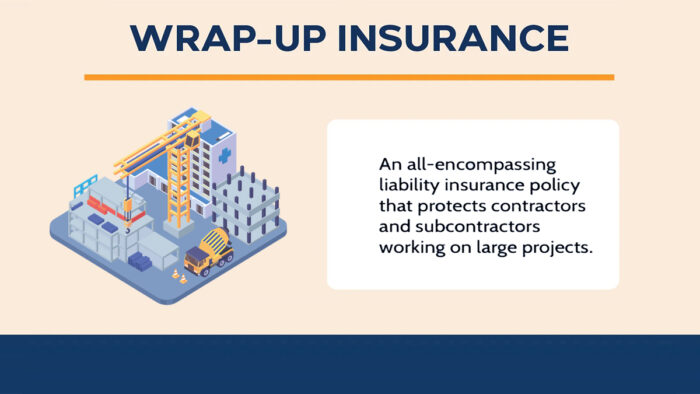If you are working on a large construction project, then getting a wrap-up insurance policy is the ideal option. This type of insurance policy protects everyone involved in working on a project.

Wrap-up insurance covers multiple parties by adding several policies into one. With a wrap-up policy, there is no need to buy individual policies for everyone working on the project. This policy is much cheaper, and the owner has the ability to choose the coverage limits.
What is Wrap-Up Insurance?
Wrap-up insurance, also known as owner-controlled insurance programs (OCIPs) or contractor-controlled insurance programs (CCIPs), is a type of insurance policy used in large construction projects. Instead of each contractor or subcontractor obtaining their own separate insurance policies, the project owner or general contractor purchases a single wrap-up insurance policy that covers all parties involved in the project.
This type of insurance typically provides coverage for general liability, workers’ compensation, and sometimes other types of insurance, such as excess liability or professional liability. By consolidating insurance coverage under one policy, wrap-up insurance can streamline the insurance process, reduce administrative costs, and potentially lower insurance premiums.
Owner-controlled insurance program policies are usually temporary and are in effect for the duration of the construction project. They provide coverage for all contractors and subcontractors working on the project, regardless of their individual insurance arrangements. This helps to ensure that there are no gaps in coverage and can simplify the claims process in the event of an accident or injury on the construction site.
How Does It Work?
Wrap-up insurance policies can cover everyone working on the job with just a single blanket business insurance policy, which ensures that every worker has the same level of coverage. Wrap-up policies usually cover worker’s compensation, general liability insurance, and umbrella liability coverage.
The insurer might also provide optional coverage that is included in the package, such as delayed completion insurance, builder’s risk insurance, environmental liability insurance, and professional liability. It is very important to have an owner-controlled insurance program because it eliminates the need for everyone working on the project to get their own individual liability insurance. If there are multiple policies, there may be a gap in the coverage.
Benefits of Wrap-Up Insurance
There are several benefits to buying a wrap-up liability policy, which include:
- Reduced costs: buying insurance for a group of people is cheaper than every subcontractor buying their own policy.
- Better coverage: the owner can choose the coverage limits and require higher limits than subcontractors might choose their own.
- Gives smaller contractors equal footing: small contractors who have a hard time finding insurance coverage can bid to join a project with a wrap-up policy.
- A wrap-up policy involves bundling multiple coverages together, so there are typically premium savings to be had.
- General contractors don’t need to worry about monitoring all their subcontractors’ certificates of insurance.
Owner-controlled insurance program protects all the contractors and subcontractors under a single insurance policy.
Types of Wrap-up Insurance Coverage
Wrap-up insurance covers several risks for you, your workers, and your project. There are different types of wrap-up insurance coverage, and they include:
• Property Damage
This type of wrap-up insurance policy covers the property damage of all the parties named on your insurance policy. The equipment floaters for special tools and equipment can also be added. The inland marine insurance for equipment and tools transported from the job site can also be added to the policy.
• Commercial Vehicle
Commercial vehicle insurance is another type of owner-controlled insurance program that protects all the vehicles used during the construction project against any damage.
• General Liability
This type of insurance covers all inabilities for a project, which includes bodily injury coverage against other third-party injuries that occur on the site. It also protects third-party property against damage that is caused by anyone covered by the insurance policy.
• Builders Risk
Builders risk covers for weather, water, and fire damages to a building under construction. The builders risk is the same as property insurance, except that it covers buildings under construction.
• Umbrella Liability
This is another type of wrap-up insurance policy that offers insurance coverage that is above the coverage limit for a basic liability insurance policy. This insurance policy covers everyone who is under it.
How Much Does Wrap-Up Insurance Cost?
There are several factors that insurance companies consider to be able to determine the cost of a wrap-up policy. Some of the factors include:
- The cost of the project.
- The size of the project.
- How long the project will continue.
- The type of wrap-up policy and its coverage limits.
- The safety and claims records of all parties involved.
- How many contractors and subcontractors are involved?
- How many phases of work are involved?
Buying a wrap-up policy can be cheaper than buying single policies. However, contractors with existing insurance policies might have to continue to pay for that coverage for jobs not listed in the wrap-up insurance policy.
How to Buy Wrap-Up Insurance
Project owners can contact their insurance provider, broker, or agent about a wrap-up insurance policy. You need to do research on the wrap-up policy to determine if the insurance policy is appropriate for a project.
FAQs
Who typically purchases owner-controlled insurance programs (OCIPs)?
Owner-controlled insurance programs (OCIPs) is usually purchased by the project owner or developer for large construction projects, such as high-rise buildings, stadiums, or infrastructure projects.
What does owner-controlled insurance programs (OCIPs) cover?
Owner-controlled insurance programs typically cover general liability, workers’ compensation, and sometimes other types of insurance, such as builder’s risk insurance. It provides coverage for contractors, subcontractors, and sometimes even design professionals working on the project.
Why would a project use an owner-controlled insurance program instead of traditional insurance policies?
Wrap-up insurance consolidates insurance coverage under a single policy, which can simplify administration and potentially reduce costs. It also ensures uniform coverage for all parties involved in the project and can help avoid disputes over insurance requirements.
How does an owner-controlled insurance program affect subcontractors?
Subcontractors working on a project covered by owner-controlled insurance programs (OCIPs) typically do not need to purchase separate insurance policies for that project, as their work is covered under the wrap-up policy provided by the project owner or developer.
Are there any drawbacks to owner-controlled insurance program?
While owner-controlled insurance programs (OCIPs) can offer benefits such as centralized coverage and potential cost savings, it may also involve additional administrative burdens for contractors and subcontractors. Additionally, some contractors may prefer to maintain control over their own insurance policies rather than relying on a wrap-up policy provided by the project owner.
How long does wrap-up coverage last?
Wrap-up insurance coverage typically extends for the duration of the construction project, from groundbreaking to completion. In some cases, coverage may be extended for a period after completion to account for potential liability issues that may arise after the project is finished.
Is an owner-controlled insurance program required for all construction projects?
Wrap-up insurance is not required for all construction projects, but it is often used for larger projects where multiple contractors and subcontractors are involved. The decision to use an owner-controlled insurance program depends on factors such as the size and complexity of the project, the preferences of the project owner, and the requirements of lenders or other stakeholders.


